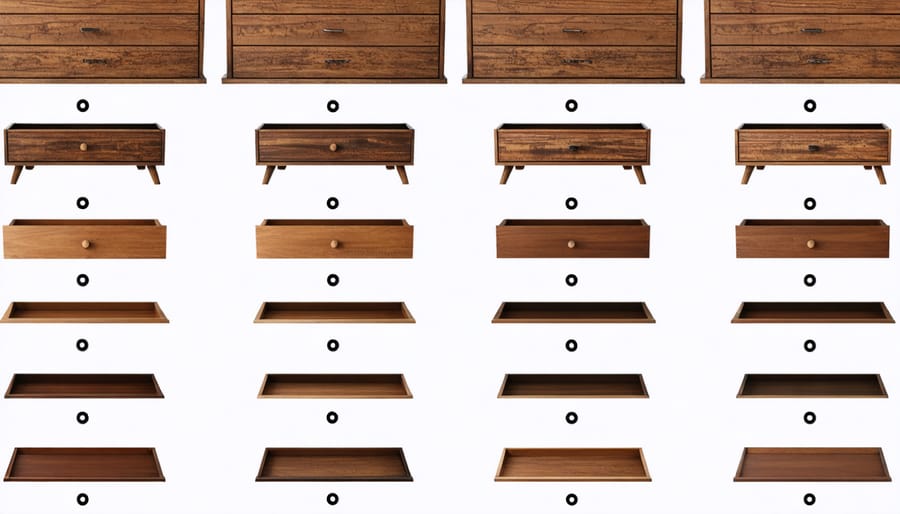Transform your bedroom’s environmental impact with a sustainable dresser that combines style, functionality, and eco-consciousness. Modern furniture choices extend far beyond aesthetics – they reflect our commitment to protecting our planet’s precious resources. A thoughtfully chosen sustainable dresser, crafted from responsibly sourced materials like reclaimed wood, bamboo, or FSC-certified timber, reduces deforestation while adding character to your space. These pieces often tell unique stories through their materials, whether salvaged from historic buildings or grown in managed forests that support local communities.
Beyond the environmental benefits, sustainable dressers offer superior durability and timeless appeal that mass-produced alternatives simply can’t match. The natural variations in recycled wood grain create one-of-a-kind pieces that become more beautiful with age, while non-toxic finishes ensure healthy indoor air quality for you and your family. By investing in sustainable furniture, you’re not just organizing your clothes – you’re making a conscious choice to support ethical manufacturing practices, reduce waste, and create a healthier home environment for generations to come.
Natural Wood Care Essentials

Chemical-Free Cleaning Solutions
Keeping your dresser clean doesn’t require harsh chemicals that can harm both your furniture and the environment. By embracing eco-friendly cleaning methods, you can maintain your dresser’s beauty naturally. Here’s a simple recipe for an effective wood cleaner: mix equal parts white vinegar and olive oil, then add a few drops of lemon essential oil for a fresh scent.
For regular dusting, try a microfiber cloth slightly dampened with water. This method traps dust instead of dispersing it into the air. For stubborn stains, create a paste using baking soda and water, applying it gently with a soft cloth in circular motions.
To polish your dresser, consider using pure beeswax or coconut oil. These natural alternatives not only shine but also help protect the wood. For drawer tracks, a light dusting followed by a quick wipe with a cloth dampened in diluted vinegar solution keeps them running smoothly.
Remember to always test any cleaning solution on a small, hidden area first, and never oversaturate wooden surfaces with liquids. These gentle, natural cleaning methods will help preserve your dresser while keeping your home chemical-free.
Sustainable Polishing Methods
When it comes to polishing your wooden dresser, nature offers some wonderful alternatives to chemical-based products. A simple mixture of olive oil and lemon juice creates an effective, natural polish that nourishes the wood while adding a beautiful shine. Mix one part lemon juice with two parts olive oil, apply with a soft cloth using circular motions, and let it absorb for 5-10 minutes before buffing.
For regular maintenance, beeswax-based polishes provide excellent protection while being completely biodegradable. You can make your own by melting pure beeswax and combining it with jojoba oil, which closely resembles the wood’s natural oils. Apply a thin layer with a lint-free cloth and buff to a gentle shine.
Another eco-friendly option is using vinegar and water solution (1:4 ratio) for cleaning, followed by a light coating of coconut oil for protection and shine. For stubborn marks, try sprinkling baking soda on a damp cloth and gently buffing the area.
Remember to always test any polish on a small, hidden area first and avoid excessive application, as even natural oils can build up over time. These sustainable methods not only protect your furniture but also keep harmful chemicals out of your home and the environment.
Preventive Maintenance Strategies
Climate Control Tips
Wood furniture thrives in a stable environment, and maintaining proper climate control is key to preserving your sustainable dresser for years to come. Aim to keep your room temperature between 65-75°F (18-24°C), as extreme temperatures can cause wood to expand, contract, or warp.
Humidity is equally crucial – the sweet spot is between 40-50%. Too much moisture can lead to swelling and mold growth, while too little can cause cracking and joint separation. Consider using a hygrometer to monitor humidity levels in your space. During humid summers, run a dehumidifier to protect your dresser from excess moisture. In dry winter months, a small humidifier can help maintain optimal conditions.
Keep your dresser away from direct sunlight, heating vents, and air conditioning units. These can create localized temperature fluctuations that stress the wood. If possible, position your dresser against an interior wall rather than an exterior one, as these tend to have more stable temperatures.
For added protection, use natural beeswax polish periodically to create a moisture-resistant barrier. When arranging items on top of your dresser, use coasters or protective pads to prevent moisture from cups or vases from seeping into the wood. By maintaining consistent climate conditions, you’ll significantly extend the life of your sustainable dresser while reducing the need for repairs or replacement.
Proper Weight Distribution
Proper weight distribution in your dresser isn’t just about organization – it’s crucial for maintaining the longevity and structural integrity of your furniture. Start by placing heavier items like jeans and sweaters in the bottom drawers to create a stable base. This prevents the dresser from becoming top-heavy and reduces the risk of tipping.
When organizing each drawer, distribute items evenly from side to side. Avoid concentrating weight on one side, which can strain the drawer slides and cause uneven wear. For maximum stability, try to keep the heaviest items centered rather than pushed to the back or front of the drawer.
Consider the weight capacity of each drawer – most are designed to hold between 30-50 pounds. If you’re storing heavy items like books or electronics, spread them across multiple drawers rather than overloading a single one. This prevents drawer bottoms from sagging and maintains smooth operation of the sliding mechanisms.
Keep frequently used items in middle drawers at comfortable reaching height. This practical arrangement not only makes access easier but also helps distribute regular wear and tear more evenly throughout the dresser. Remember to periodically reorganize drawers to prevent permanent stress points from forming in any one area.
For delicate items, use drawer organizers or dividers to maintain even distribution while protecting your belongings. This systematic approach to drawer loading will significantly extend your dresser’s life while keeping your items easily accessible.

Eco-Friendly Repairs
Natural Wood Fillers
When your dresser shows signs of wear, natural wood fillers offer an eco-friendly solution for those unsightly scratches and dents. Start with simple kitchen ingredients like a paste made from sawdust mixed with natural wood glue, which perfectly matches your dresser’s existing color and grain pattern. For smaller scratches, try rubbing a walnut or Brazil nut directly on the affected area – the natural oils help camouflage imperfections while nourishing the wood.
Another effective DIY filler combines beeswax with carnauba wax and natural earth pigments to create a malleable putty. Heat the mixture gently, apply it to the damaged area, and smooth it level with a putty knife. Once cooled, buff the surface with a soft cloth for a seamless finish.
For deeper gouges, create a sustainable wood filler by mixing fine sawdust with natural oils like linseed or tung oil. This combination creates a durable repair that ages naturally with your furniture. Coffee grounds mixed with wood glue offer another eco-friendly option, particularly effective for darker woods.
Remember to test any filler on an inconspicuous spot first, and always sand the repaired area gently with fine-grit sandpaper before applying your chosen natural finish.
Hardware Maintenance
Maintaining your dresser’s hardware doesn’t have to harm the environment. Start by cleaning drawer pulls and hinges with a mixture of equal parts white vinegar and water, which naturally dissolves grime and tarnish. For stubborn buildup, create a paste using baking soda and lemon juice, applying it gently with a soft cloth.
To prevent squeaky hinges, skip petroleum-based products and opt for natural alternatives like coconut oil or beeswax. Apply a thin layer every six months, working it into the moving parts. For loose handles or pulls, tighten them promptly using the appropriate screwdriver to prevent further wear.
Remove rust naturally by soaking affected hardware in white vinegar overnight, then scrubbing gently with a soft-bristled brush. For brass or copper hardware, create a natural polish using a paste of flour, salt, and vinegar. Apply, let sit for an hour, then buff with a clean cloth.
Consider upgrading to recycled or sustainably sourced hardware when replacements are needed. Many artisans now create beautiful pulls and handles from reclaimed materials, giving your dresser an eco-friendly refresh while maintaining its functionality.
Remember to inspect hardware monthly for early signs of wear, addressing issues promptly to extend their lifespan and reduce waste.
Upcycling and Restoration
Natural Refinishing Techniques
When it comes to sustainable furniture restoration, natural refinishing techniques offer a gentler approach to breathing new life into your dresser. Start by creating a homemade stripping solution using equal parts citrus oil and white vinegar, which effectively breaks down old finishes without harsh chemicals. For stubborn areas, try a paste made from baking soda and water, gently working it into the surface with a soft cloth.
Once you’ve removed the old finish, sand the wood using recycled or biodegradable sandpaper, working gradually from coarse to fine grit. Remember to sand in the direction of the wood grain to avoid scratches. Clean off all dust with a tack cloth made from natural fibers.
For the new finish, consider plant-based oils like linseed, tung, or hemp oil. These natural alternatives not only protect the wood but also enhance its natural beauty while being safe for both your home and the environment. Apply thin coats with a lint-free cloth, allowing each layer to dry completely.
To seal your work, beeswax offers an excellent natural alternative to synthetic sealants. Mix it with a small amount of carnauba wax for added durability, and buff it to a beautiful shine using a soft cloth. This combination provides lasting protection while maintaining the wood’s natural look and feel.

Creative Updates
Give your dresser a sustainable makeover by focusing on its decorative elements and hardware. Start by exploring creative upcycling ideas for drawer pulls – consider using reclaimed materials like vintage doorknobs, repurposed leather straps, or even smooth beach stones as unique handles.
For a modern touch, sand and paint existing metal hardware using eco-friendly paints. You can create striking designs by mixing natural materials: think cork and bamboo accents, or woven grass rope wrapped around existing pulls. Local artisans often craft beautiful ceramic knobs that make excellent sustainable alternatives to mass-produced options.
Don’t overlook the power of decorative elements. Natural materials like pressed leaves or flowers can be sealed under non-toxic resin for stunning drawer fronts. Create patterns using sustainable wood veneers, or apply handmade paper using non-toxic adhesives for an artistic touch.
Consider adding mirror fragments from recycled glass, or create a mosaic using broken pottery pieces. For a simpler approach, use natural twine or jute to wrap drawer edges, adding both texture and visual interest while maintaining eco-friendliness.
Remember to seal any decorative additions with natural finishes to ensure longevity. These creative updates not only personalize your dresser but also contribute to a more sustainable home environment.
Embracing sustainable care practices for your dresser not only preserves its beauty but also contributes to environmental conservation. By choosing natural cleaning solutions, performing regular maintenance, and addressing issues promptly, you’re extending your furniture’s lifespan while reducing waste. These eco-friendly approaches save money in the long run and help create a healthier home environment free from harsh chemicals.
Remember that preventive care is the cornerstone of sustainable furniture maintenance. Simple habits like using coasters, dusting regularly, and maintaining optimal indoor humidity can add years to your dresser’s life. When repairs are necessary, choosing natural materials and environmentally conscious methods ensures you’re staying true to sustainable principles.
The investment in sustainable dresser care pays dividends not just in preserving your furniture, but in contributing to a more sustainable future. By passing these practices on to future generations and inspiring others to adopt eco-friendly furniture care, we create a ripple effect that benefits both our homes and the planet. Your dresser can remain a beautiful, functional piece of furniture for decades to come while minimizing its environmental impact.
